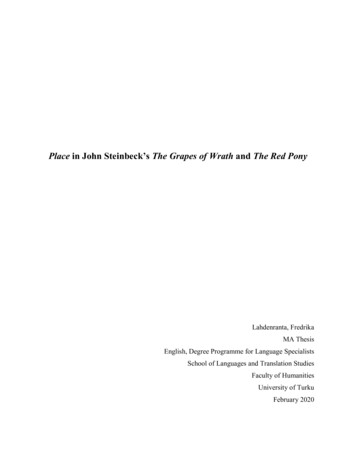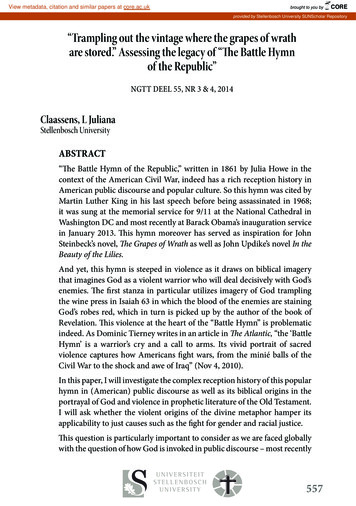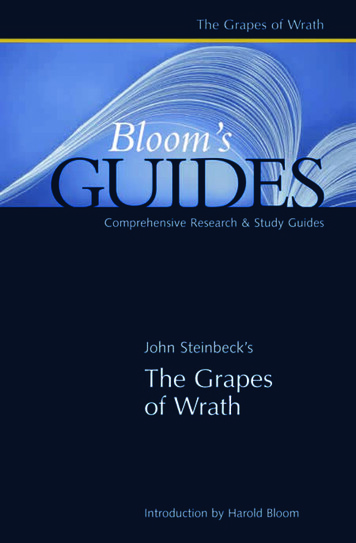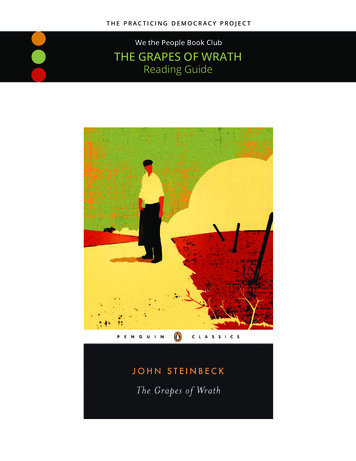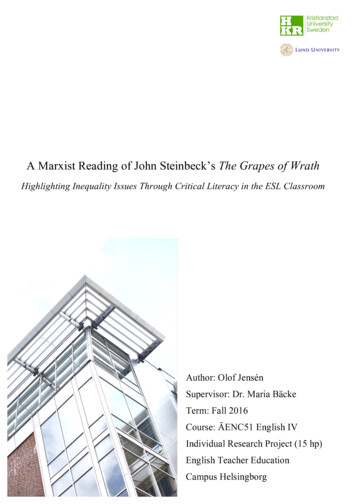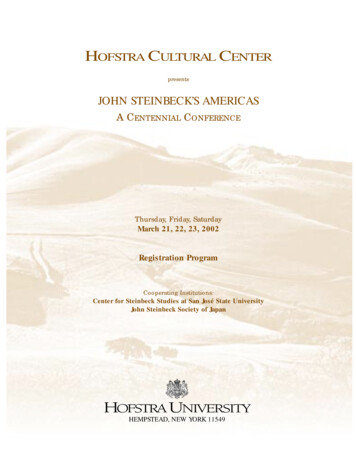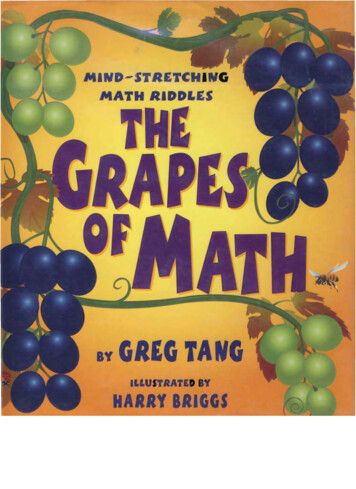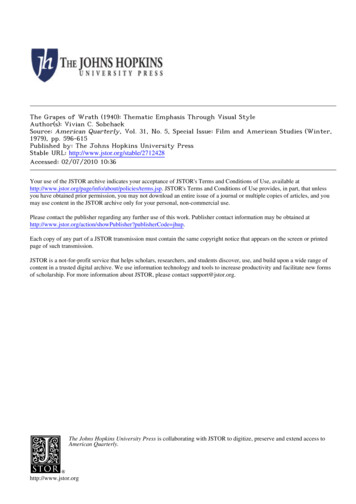
Transcription
The Grapes of Wrath (1940): Thematic Emphasis Through Visual StyleAuthor(s): Vivian C. SobchackSource: American Quarterly, Vol. 31, No. 5, Special Issue: Film and American Studies (Winter,1979), pp. 596-615Published by: The Johns Hopkins University PressStable URL: http://www.jstor.org/stable/2712428Accessed: 02/07/2010 10:36Your use of the JSTOR archive indicates your acceptance of JSTOR's Terms and Conditions of Use, available rms.jsp. JSTOR's Terms and Conditions of Use provides, in part, that unlessyou have obtained prior permission, you may not download an entire issue of a journal or multiple copies of articles, and youmay use content in the JSTOR archive only for your personal, non-commercial use.Please contact the publisher regarding any further use of this work. Publisher contact information may be obtained herCode jhup.Each copy of any part of a JSTOR transmission must contain the same copyright notice that appears on the screen or printedpage of such transmission.JSTOR is a not-for-profit service that helps scholars, researchers, and students discover, use, and build upon a wide range ofcontent in a trusted digital archive. We use information technology and tools to increase productivity and facilitate new formsof scholarship. For more information about JSTOR, please contact support@jstor.org.The Johns Hopkins University Press is collaborating with JSTOR to digitize, preserve and extend access toAmerican Quarterly.http://www.jstor.org
THE GRAPES OF WRATH (1940):THEMATIC EMPHASIS THROUGHVISUAL STYLEVIVIAN C. SOBCHACKSalt Lake City,UtahSINCEITSRELEASEIN1940, THEFILMVERSIONOFTHE GRAPESOFcriticaland popularattenWrathhas attractedenormousand enduringtion.' Yet, in some ways it has also remaineda neglectedfilm,a he Grapes of Wrathwas and stillis a highlyvisiblefilm;itsas a "classic" is evidencedby its frequentappearanceonpopularitytelevisionseries,at cinemaclub y.In addition,thefilmenjoysa adaptationof a workof fiction,as a culturalartifactandas ericanhowever,thiswidelyconoeuvreof a majorfilmauteur.Paradoxically,fromvisual neglect.Examinedfromseveralsideredfilmhas sufferedcriticalperspectives,The Grapes of Wrathhas been morefrequentlylookedintothanlookedat. Its visualsurfaceshavebeenhardlyexploredas itstexturethematicemphasishas been onlyminiand its dominantof its imagery,mallyrelatedto itsvisualstyle.can be linked,ofoversightThe reasonsforthisliteraland ndedbyfocusedandlimitedofaa comparisonforexample,is ticallyhowsophisticatednovelandfilm.And,no matter' JohnFord directedThe Grapes of WrathforTwentiethCentury-Fox.
The Grapes of Wrath597towardtendto gravitateis, itscomparisonscriticismate and structurestheliteraryofcriticis ignoranttheliterature/filmthetwo artforms.Thus,whetherwithfilmaesthetics,ofa film'svisualtextor conversantthecomplexityseemsto considera dictateitsstructuresof geBlueand thematicaction,characterization,narrativeNovels intoFilm and e to The Grapes of Wrathspend the major portionof adherencetoordeparturefromSteinbeck'sparentworkon thebasis of dialogueselection,scenedroppedor synthesized,deletionsor additions,charactersmaintained,Whatthe imageof narrativeactivity.2arrangementand the structuralof whathappensin it. Thelooks like is neglectedfora considerationSimilarly,to its visualtreatment.subjectmatteris considereddominantthanhow the imageswhathappensnextis t.Indeed,imagesareignoredas affectiveofmeaningand texturewhichaccrueto expressthefilm'sthemein conasdevices.Rather,theyare inateandthroughwithinplaceto whatdialogueand actiontakeimportancethem.AlthoughbothBluestoneand Frenchdescribevariousvisualasin theirrespectivepects of The Grapes of Wrath,theyhave difficultyfilmand sis,theirdifferingfromabothderiveto Steinbeck'snovelof thefilmand its relationshipfilmtext.approachto theliteraryprimarilyinthefilmisA similarapproachis asdamnedaswellrelevancecourageousrealismand its socialtoitinthepretendedand timidity addressing edtackle.It has also been analyzedbarometer,expressiveofthose"meaningsand valuesthatwerea partofculture"3 at thetimethefilmwas madeand seen. If thethe dominantitis oftentooliteralinitsresponseculturalapproachis notquiteliterary,and e,fromvisualpendently2 George Bluestone, Novels Into Film (1957; rpt. Berkeley: Univ. of CaliforniaPress,1973); Warren French, Filmguide to The Grapes of Wrath (Bloomington:Indiana Univ.Press, 1973).3 Charles J. Maland, AmericanVisions: The Films of Chaplin, Ford, Capra, and Welles,1936-1941(New York: ArnoPress, 1977),367.
598American efilmdealtwithrelativelytheworldand theplightofDust Bowlseemedto articulatecinematicallyand thatthematerialcontentofitsimagesborea superficiallymigrants,farto nggreatercriticalattentionmentof its subjectmatterand physicalcontent.Indeed,the filmwastoinitiallyreviewedand apotheosizedmorein termsof its relationshipto documentaryrealism,thantreatedas a successfuladaptationactuality,fictionand art.Lifemagazinecalleditofa novelor a workofcinematic"bitter, authentic,honest,'"4 and Edwin Locke, a documentaryfilmsofwiththe raphsit "set a precedent for contemporaryand historical honesty heGrapesof WrathhasCertainlythefilm'ssocialworthon thebasisofitsmovedfarafieldfrommeasuringhas swungtheotherwayandthefilm'svaluerealism.Now thependulumto itsexpressionofais basedon itsrelationto myth,as a and,forexample,sees conveyeda patternuniversemeantto presenttheconstructionof"a symbolicthroughformto a broadaudience."ofvaluesand meaningsin a popularfictionalof such culturalanalysis,theBut despitethe increasedsophisticationnotionofsocialvisionis linkedonlyrarelyto ivetionofthefilm'simagesandvisualtextureand is one ina numbera theAmericananotherto affirmation,at largefroma social criticismcan filmindustrybetween1936and tionis nevergiventheampleand smOne ctedtowardThe Grapesoftheliteralemphasisof culturalcriticismattentionWrathwouldbe counterbalancedbythemorevisually-orientedof filmcriticism.Not boundthroughintentor academicdisciplinetoitsplace in a culturalandcomparethefilmto thenovelor to investigatehistoricalgestalt,cineastesmightbe expectedto considerthefilmmore4French, 59.5Edwin Locke, review of The Grapes of Wrath,Films (Spring 1940), rpt. in AmericanFilm Criticism,ed. by Stanley Kauffmannwith Bruce Henstell (New York: Liveright,1972),389.6Maland, ix, 169-70.
The Grapes of Wrath599freelyas an autonomousworkof visualas well as verbalart.Unfortunately,suchhas notbeenthecase. As Steinbeck'snovelhas obscuredtheless verbalaspects of the filmfromliterarycritics,and as the film'srelationshipto a particularlyfascinatingperiodofsocialand culturalhistoryhas narrowedthefocusofculturalcritics,so hasJohnFord'spositionas a s.Ratherthanbeingconsideredon its own meritsand discussedon the basis of itsaestheticdevelopmentand coherence,The Grapes of Wrathhas beenregardedprimarilywithinthecontextof Ford's entirebodyofwork.Assuch,it has been eitherseen as less thana majorworkand ignored,ordiscussedless visuallythanthematicallyas riscalls a "nostalgic"and "familylevelofhistory."7In thefirstinstance,thefilmis oftengivenshortcriticalshriftin Ford'sbecauseitis nota Western,becauseitwas madeat a mid-pointthanhis workin the 1930sandcareerwhichhas garneredless attentionafterthe1940s,and becauseitis regardedas somehowless "pure" Fordforbeingan adaptationof a classic novel.(It is interestingto notethatmostoftheclose textualanalysisofFordfilmsis practicedon thosenotFordused literarysourcesforand thatalthoughadaptedfromliterature,and Stagecoachhave meritedtenof his films,onlyThe Informernearlyunanimouspraiseand attentionfromcineastes.8)In thesecondinstance,thatfilmcriticismwhichhas dealtwithTheGrapesof Wrathinanydetailhas doneso intermsofitsthematicconcernsas derivedfromitsnarrativeand itsgeneralresemblancestructureto otherFordfilms.The ohowa givencriticfeelsaboutFord.For stalgiaits roicchampionsofan agrarianorderoffamilyandcommunity"'9is clearlyone ofthefilm'schiefvirtues.On theotherhand,in a testhedirectorand hisworkforpoliticalconservatismand easy sentimentalityand says disparaginglyof TheofDreiserandDos Passos andGrapesofWrath,"Ford thecontemporaryeven Steinbeck gives us . . . a hollow celebration of that emptiestabstraction,The People,alongwitha cop-outanalysiswhichavoidsblam7 AndrewSarris,The AmericanCinema, Directorsand Directions1929-1968 (New York:E. P. Dutton, 1958), 43-49, quote p. 44.8 The two most detailed textualanalyses of specificFord filmsare "John Ford's YoungMr. Lincoln," Screen, 13 (Autumn1972) translatedfromthe originalin Cahiers du Cinema,No. 223 (1970); and "The Searchers: Materialsand Approaches," Screen Education, No. 17(Autumn1975). See also H. PeterStowell, "John Ford's LiterarySources: FromRealism toRomance," Literature/FilmQuarterly,5 (Spring 1977), 164-65.9 Sarris, The American Cinema, 45.
600American QuarterlyfortheplightoftheOkies."10These stateor interestinganyindividualments,however,whetherforor againstFord as a filmartistof meritedofthefilm'simagery.are notbackedup bycarefulconsiderationstature,thatimageryis too oftenassumedas a givenby criticsUnfortunately,anxiousto geton withthejob of dealingwithFord's themes.As Pierreofpresents"an expositionnotes,a greatdeal ofsuchcriticismGreenfieldofit." II ilosophyand culturalcriticsin theirgeneralneas guiltyas literaryare thereforeglectofthevisualelementsofThe Grapesof ghtThistripartiteThe Grapesof Wrathis a greatworkoffilmart(whichis arguable),butbecauseitis afilmanditis shownon a screenandhas a visualpresence.The way we read and perceiveit is as mucha functionof its visualcontent.Indeed,inandculturalanddramaticas itis ofitsliteraryimageryof a film'svisualimageryis atand immediacymostcases the equal to ifnotfargreaterBecause ofthispower,a film'svisualor articulated.is notacknowledgedandof literarywhenit is supportiveimagerymeritsas muchattentioncontradicanalysesas whenitis moreflamboyantlyculturalandthematictoryor quietlysubversive.In thecase ofTheGrapesof Wrath,theconsensusof criticalresponsehas been nearlyunanimousin itsrecognitionin toneand spiritfromSteinbeck'snovelandthatFord'sfilmis differentand poeticworkwhose majorconservativethatthefilmis a politicallyThatconsensusfamily.themeis tructuralanwas notarrivedat merelyby to rt,place in a gestaltof rapesofWrathwas also fthefilm,bytheintuitiveof thatimageryand its functionintothe criticalact. The apprehensionand nbeck'sbooktothescreenIt is agreedthatFord'stransliterationrealisticand politicalnovelandthevaluesof an parentworkwhichare themostconsistbothownvaluesand anSteinbeckand Forddo sharea and Film Quarterly,28 (Summer1975),5.11PierreGreenfield,"Printthe Fact: For and Againstthe Films ofJohnFord," Take One,5 (Nov. 1977), 15.10 Michael Dempsey, "JohnFord: A
The Grapes of Wrath601tions and ideas throughthe medium of proletariatprotagonists,and intheiruse ofhumorand folklore,theirsympathiesand interestsare dramatically divergent.Steinbeck's novels emphasize the importanceof thepresent,the harshnessof reality,the potentialof radical politics,and theneed forsocial and politicalchange. Conversely,Ford's filmsemphasizethe values of the past and softenthe harsheraspects of historicalrealitywith nostalgia; his filmworlds are apolitical and atemporaland his aestheticevocationof Americarevolvesaroundthe harmonyand establishedtraditionsof community.Indeed, his life's work reveals a reverenceforthose human values which are most simple and universal, a reverencewhich balks and tremblesat the necessityfor progress and change. AsAndrewSarriscogentlyindicatesin TheJohnFord Movie Mystery,"Fordnever lost his faithin the benigndriftof Americanhistory. . . and intuitivelyredirectedthe pessimisticclass conflictsin . Steinbeck . . intorelativelyoptimisticfamilychronicles." 12The novel, however,is less concernedabout seven monthsin the lifeofthe Joad familythan it is about the relationshipof men to land, about anuntenable economic system, and about the inevitable awakening of acommunalrevolutionaryconsciousness in the oppressed and exploited.The Joad familyis only a sharply-focusedpoint fromwhich the novelcontinuallymoves out far beyond the limited awareness of its maincharacters to deal with epic social and political issues, abstractionswhich-of dramatic necessity-must find embodimentin the concreteand specific, in characterizationand action and the details of physicalimagery.Althoughthe Joad familytakes on the bulk of this dramaticfunctionin the novel, Steinbeck has structuredthe book in such a waythatthe readercannotforgetthatthe familyis only one of manyfamilies,thatit is partof a largerorganismcomposed not only of familiesbut alsoof land and plants and animals and weather. The Joads are constantlycounterbalancedby the equal emphasis given in the intercalarychaptersto largerissues than theirimmediatesurvivaland on largergroups thanthefamily.As a result,theirfamilyunitis not metaphoricalin function;itis, instead, illustrative.Its importancein the novel is not in its mythiccohesion and endurance, but in its realistic specificity.The Joads comprise onlyhalfof the novel's emphasis,enjoy only halfits attention.Andtheuniversalthemeof familysolidarityis greatlysubordinateto the largeremphasis Steinbeck gives to a cry forthe solidarityof men in a definitepoliticaland economic context.Indeed, as WarrenFrenchpointsout, thenovel chartsthe progressof the Joads' "growingout of the narrowcon12Andrew Sarris, The John Ford Movie Mystery(Bloomington:Indiana Univ. Press,1975), 161.
602American Quarterlycept of 'fambly'in the blood-relationshipsense to a conceptof membershipin theentire'humanfamily.'"a 13As has been pointedout by manycriticsincludingthosecitedhere,Ford is notparticularlyconcernedwiththe Joads' integrationintothein relatingthemto anfamilyof man. Nor is he particularlyinterestedeconomicor politicalmilieu.Althoughthereis a greatdeal to a largerpopulation,andtoa mis on theJoadsasan isolatedand and specificityof timeand place. Certainly,the Joads on tis thenatureofrealization;themediumto particularize"characters"and "place" farmoreexactlyand idiosyncraticallythanwrittenlanguage.But thevisualtreatmentofHenryFonda's Tom,JaneDarwell'sMa, CharleyGrapewin'sGrampa,JohnCarradine'sCasey,and and resonatesphotographicspecificityinto expressivemetaphor(see Figure1). Because ofthemannerin vedandshot,Steinbeck'smultiplethemesand simultaneousemphasishave been exchangedfora less epicbutequallyuniversalvision,fora scope at once onomicsandsocialrealitiesto thesize ofa singleromanticizedand yetalso a scope largerthanthenovel'sfamily,in its evocationof the survivaland enduranceof thatfamilyagainstastylizedbackgroundwhichis not limitedby time and space. WhileCharlesMalandsuggeststhatFord's emphasison theJoadsas a familialand communalunitcan be linkedto the director'snaturalaffinityforJeffersonianto his beliefin independentof irbeingdispossessedoftheirland. Indeed,it is theirlack nionwithanyonebutthemselves.Thus, wherethe novelmovesout bothstructurallyand imagisticallyfromthe Joadsto continuallyemphasizethe grantson themove,thefilm'smovementvisuallycloses in on theJoads,at timesto sucha degreethattheyhaveconnectionwitheitherthelandor therestofsociety.Theonlya minimalof course,do pay lip serviceto thatconnectionthroughthecharacters,1314French, 27.Maland, 164-66.
The Grapes of ace.Figure1. alityoftheLesterGlassnerCollection.)ofTheGrapesof Wrathare courtesy(Allphotographsscriptalone mightdialogue-so muchso thata readingofthecontinuityfilmfromthe one actuallyresultin the impressionof a quitedifferentis notactuallyvisiblethroughrealizedon thescreen.Butthatconnectiona greatportionofthefilm.Land is notas visibleas whatFrenchcalls filmfresh,temporaryor on thestudiolot ratherthanon locationin a landscapewhichmighthave matchedthe visualpowerand presenceof the MonumentValleyFordused in so manyofhisWesterns.Thoughthereare somebrieflongshotsofauthenticlocationsin someofthemontagesequences,theiropenof thefilm'9soverwhelmreminderservesas a strikingqualityprimarilyIfat the nglyas a pesofSome earlycriticsnotedthisabsenceof land imageryin thefilmandremarkedon Ford's departurefromSteinbeckin thisregard.Generally,attunedto ves,'5 French, 18.
604American Quarterlyqualities of film. Edwin Locke, for example, came to the filmwith abackgroundas a memberof the U.S. Film Service, a governmentagencywhose filmsspecialized in evokingthebeautyof theAmericanlandscape:hasnotcomethroughas wellas hisIt is a pitythatFord'ssenseofenvironmentweakenedbecausehe hassenseofpeople.The openingofthepictureis greatlyWhereare theor thepeople'sbackground.givenus no feelingofthecountryof thedustbowland thetinyhousesas lonelyas shipsat sea?vast stretchesWhereis thedust?It is hardto believethatFordhas everseenThePlow Thattohearthata cameracrewwas sentto OklahomaBrokethePlains.It is bafflingbuta fewfeetoftheirfilmwas used. It is regrettablealongRoute66; esnatchedacrossthebeautifulin a fewpansandprocessshots;we couldjustlyhaveexpectedmore.countryofftheland,We couldhave expectedmoreof whatit is liketo be tractoredat large,roamingmorethantheknockingoverofa prophousebya Caterpillarin na hackneyedifFordhadfolloweda littleanda richerpicture,We mighthaveall thesethings,thedocumentarythatis hhiswork.16Similarly,Pare Lorentz, directorof The Plow That Broke the Plains andThe River, was disappointedby the lack of will to evoke the land and itsmoods:neededto thinkin termsofskiesthescreenwriter]Johnson,. he e klahomaclear up to Canada, withtheirmiserablehutsand bustedofOklahomawindmills.In fact,he neededonlyto havegoneto thepanhandleandTexas said:this-hereis wheretheycamefrom.""PhotographAs he ionParkhisoutdoorsequencesinStagecoach,madea Westernin Utahto photographhispicturewithactionpictureintoa thingofbeauty)at enesthat,even thoughtheywerefromthebook,did notgiveyoua feelingoftheland.'7Less importantfor theirrecognitionof how Ford's filmbroke a certainfaithwithSteinbeck's book or withnaturalhistorythanfortheirrecognition that the visual images of a filmare crucial to its meaning, these16Locke, 387-88. (The Plow ThatBroke thePlains was made in 1936by Pare Lorentz forthe U.S. Film Service.)17 Pare Lorentz, review of The Grapes of Wrathin Lorentz on Film (New York: Hopkinson and Blake, 1975), 184.
The Grapes of Wrath605indicatetheclosed qualitywhichpermeatesFord's work,hiscommentsvisual choice whichomitswide-openspaces and panoramicvistas ofeitherparchedearthor aythem,disconnectsthem,perhapseven protectsthemfromlargerforceswhichgivethenovelan epic quality.and largermovementsof The Grapesof Wrathis consciouslyconThe generalcompositiontrolledand tight.For the mostpart,theactionoccursin rbyitsactualspatialparametersbytheamountofitwe are allowedto see byvirtueofthegivenilluminaone brieflong shot-we movetion. Rightfromthe chesa rideandwe areconfinedorlookinginclose-upthroughinthecab ofa truck,crampedinitsinteriorthattheat Tom and nsistsalmostentirelyof the Joads ridingin theirramshackleit is truethatthe charactersare usuallytruck"18is an exaggeration,screenandlimitedspace(see Figure2). Notonlycrampedintoa clutteredis a gooddeal oftheJoads'odysseyconfinedand isolatedin automotiveindoors:actionis also confinedbuta largeshareofthedramaticinteriors,rooms,tents,or shacks,all 0 "scenes" Frenchdescribesas comprisinginthecharacters.or in part)withinthetheunitsofthefilm,a totalof25 are shot(entirelyJoadtruckor withinan oppressiveinterior.19whichoccurin "open space" are also chafinglyThose compositionscontainedand limitedby theircardboardand set-likequalityand by elackofinternalwithCaseytakesplace inforexample,Tom's initialencounterAlthough,willowtree,theby an overly-aestheticizedan "open" fieldpunctuatedcamerastaysin one spotand footto foot.shiftingoccasionallyand uncomfortablyin such a way, Ford containsthetheirphysicalmovementContainingis thatthereis nofieldoutsidethelimitsofframeas well.The visualeffectthecamera'svision,no land-rather,thereis a non-space,ora studiosetcoveredwithfalse and aestheticizedearth.The long long shot whichagainsttheconcludesthe sequence showsTom and Casey silhouettedskyas theyset out forthe Joadhomestead.But the shotdarkeninghoweverlongand panoramic-ismoreclosedthanopen,morememoraand staticvisionthanitislightingble foritscomposedqualityand artfulforan evocationof a realworldwithrealearthand dustwhichis reallyMaland, 154.19French, 38-56. (I have not includedthose scenes shot in brightlylit interiors.)18
606American QuarterlyAn: .e- . t .A9.';4.'.'.lIBM'01,. . .!. .i-0.l iis oftenabstractedfromcontextthroughframing.Figure2. The Joadfamilyblowingaway. Uncle John'sfarmyardis no moreopen spatiallythanawhichpretendsto realism.AndboththeKeene tPatchgovernmentcampseempatentlytiveevocationsof squalorand darknessand spankingclean brightness.is notnecessarilynegative,The effectofthisspatialclosureon thefilm,but it does communicatethe visual messagethatthe worldwhichtheJoads inhabitis less than real and vital. Their vitalityagainst tings,grimnessthanthe hilethe Dehighlightedtheyare physicallypresentand heblowingawaypressionan abstractedstageset or The staticcompositions,posturingalso add to ternand specificand versaland iconic.The cameraand endurancesomethingtheirstruggleforthe mostpartto look at its subjectsfromrarelymoves,preferringeye-level and mid-distance.This point of view produces images which
The Grapes of Wrath607alook at timeslikethesameviewoftheactionone wouldgetwatchingtableau;theentirehumanfigureis seen inor historicalstageproductionout intotheframeand so theimagedoes notextenditselfimaginativelyofthecameracreatesa senseofthetheworld,andtherelativeimmobilityand exitingfromwingsas opposedto the eralpatternseekingthemout.The oneliterallyis thevisualtreatmentandcameraand subjectmovementofcompositiongivento the Joad's entranceintoHooverville,and to the fightwhichofcamerawhichmovesas a memberoccursinthattentcity.The subjectivethestreetvisuallyopensup thefilmas it,paradoxthroughtheJoadfamilyBoththe subjectivevisionand the cameraically,limitsits objectivity.movementare morejoltingthanthe o muchmoremovesented,as is thelaterfightthethanwe have seen before.Indeed,generallymentand randomnessdramaticactivityor stage "business" withinthe frameis ativetaneousorrandom,to say(a "speech" suchasimportantacterswhensomeonehas somethingorMuley'son being"touched,"orMa'sCasey'son notbeinga preacher,on Tom's notbecomingmean)makesthedialoguedenserthanit mightbysomerandommotion.Instead,suchspeechesbe iflightenedotherwisethecharacas tableauxremovingarephotographedare ersfroma peopledandphysicallyThe settingsof the Joad farm,of Unclearchetypeand ,inthetentsofHooverville,camp-not one ofthemhas thein theneatexteriorsof thegovernmentand extraneousqualityof realisticand immediateart oruncontrolleddocument.Not a chickenstirs,and everyobjectseemsto pose.As a spoliticalandeconomicproblemsfunctionalthanand essing.immediatelyandstressesthearchetypalThe wayin whichthefilmis editedfurthericonicaspectsof the Joadsby The Joadsexistin montagetime,forexample-shotsso as to conveythepassageor superimposedrhythmicallylinkedtogetherof timewithoutreallybeingspecific.As well, the Joadsexistin whatmightbe called "tableautime"-that is, theyare seen in set pieces,inconnectedor visuallycontinuoustoscenes whichare not dynamicallycommentedabout the perothers.WarrenFrench has aranceof Noah Joador Rosasharn'sbaby,butalso withthe use of "sharp breaksbetweenscenes" and the lack of
608American Quarterlyassociationalediting,the "switchfromone scene to anotherby cuttingfroman objectin one sceneto a similarobjectin another."He also notesthatFord "apparentlypreferredto breakthepictureintoa seriesofdiscreteepisodesby the use of sharplydelineatedfadeoutsand fadeins."These editorialdevicesadd to thefilmthe"compensatinguniversality"Frenchsees as a substituteforthe bite and timelinessof Steinbeck'snovel.The des,andeventheoneflashbacksequencein whichMuley"tells" whathappen
Grapes of Wrath, "Ford the contemporary of Dreiser and Dos Passos and even Steinbeck gives us . . . a hollow celebration of that emptiest abstraction, The People, along with a cop-out analysis which avoids blam- 7 Andrew Sarris, The American Cinema, Directors and Directions 1929

